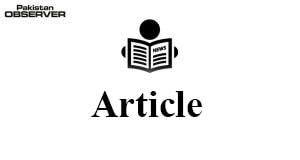Education investment impact on learning
AS compared to other countries, particularly those in the region, Pakistan is somehow ranked low in the region in terms of educational indicators such as expected years of schooling, mean years of schooling and inequality in education.
The incumbent federal government quite obviously is fully cognizant of the national education crisis, as over 22.84 million children were still out of school and as much as 41 per cent of fifth grade students unable even to read simple stories in basic languages.
According to Pakistan Social and Living Standards Measurement Survey (PSLM) 2018-19, literacy rate in the country was stagnant at around 60 per cent with urban literacy rate at 74 per cent and rural literacy rate at 51 per cent.
Literacy in Punjab province is slightly higher at 64 per cent as compared to Sindh and Khyber Pukhtoonkhwa (including merged districts) at 57 per cent and 55 per cent respectively while this rate was even lower at 40 per cent in Balochistan, area-wise largest and sparsely populated province of the country.
Furthermore, literacy rate for male population was reported to be at 71 per cent while that of female literacy rate was substantially lower at 49 per cent.
According to figures available from official sources, school attendance across Pakistan was reported to be around 60 per cent while Gross Enrolment Rate (GER) at primary level was 87 per cent and Net Enrolment (NER) was 66 per cent.
Likewise, middle level GER and NER were 63 per cent and 38 per cent respectively while matric level GER and NER figures were placed at 57 per cent and 27 per cent respectively.
Gender Parity Index (GPI) in literacy was only 0.69 per cent on the whole level while at the primary and secondary levels the figures were 0.92 and 0.89 respectively.
One of the major concerns of the authorities concerned at the federal and provincial levels was how to mitigate the loss of exacerbated learning with over 50 million learners affected due to pandemic of COVID-19 during financial 2020-21.
This situation entailed higher risk of increase in out-of-school children, widening of gender disparity d flaring learning poverty.
Concerted efforts as such were direly needed to focus on reducing huge number of out-of-school children (22.8 million, exacerbated to 50 million due to COVD-19).
Provincial governments are required to make concerted serious efforts to strengthen modules for training for training of both teachers and education managers to deal with similar challenges in the future. Improving gender parity and literacy rate were obviously the areas of special focus in the education sector.
As for the measures being taken at the federal level for improving the overall education sector in the country, as many as 23 projects were included in the Public Sector Development Programme (PSDP) 2020-21, including 20 ongoing projects and 3 new projects which were initiated by the Ministry of Federal Education and Professional Training.
These projects aimed at introducing at uniform curriculum, capacity building of teachers and principals , recruitment of teachers, establishment, renovation and up-gradation of schools and colleges, improving gender disparity, education voucher scheme, improving educational assessment system and Knowledge Economy Initiative.
The federal government was apparently committed to strengthen education system and invest on human capital development.
Projects initiated by the incumbent federal government for human capital included Tele School for Grades 1-12;National Education Action Plan for COVID-19; Establishment of National Curriculum Council Secretariat; Balochistan Human Capital Investment Project; Khyber Pukhtoonkhwa Capital Investment Project; Punjab Human Capital Investment Project, and; Sindh Early Learning Enhancement through Classroom Transformation.
As for the measures being initiated or planned by the federal and provincial governments under PSDP 2021-22 are concerned, the federal government was attaching due priority to the strengthening of basic and college education system.
Towards this end, 24 development projects including 20 ongoing projects for Basic and College Education with an allocation of Rs 4873.74 million were listed in the PSDP for ongoing financial year.
Under PSDP 2021-22, the Ministry of Federal Education and Professional Training which had taken a lead on several initiatives for improving education quality and access as well as for mitigating the education losses during pandemic of COVID-19, was allocated an amount Rs 4.7 billion .
The Ministry has also undertaken ASPIRE programme initiative for effectively countering the education inequities at inter-provincial and inter-district levels for lagging areas all over Pakistan.
Substantial amount of Rs 4 billion was in the process of being disbursed to reduce imbalances in education quality and accress.
Two major programmes namely Response Recovery and Resilience Project and Pandemic Response Effectiveness in Pakistan have also been launched for addressing disparities disruption in education continuity and learning losses due to continued prevalence of the pandemic.
Interactive and digital content for tech-based media was also in the process of being created , updated, contextualized and disseminated through television, radio and prevalent education technology platforms.
Similarly, other programmes included provision of basic education missing facilities, establishment/ up-gradation of boys and girls schools and colleges, knowledge economy initiatives, teachers training institutes etc.
National Curriculum Council Secretariat has also been set up for ensuring effective coordination among federating units in development and reviewing of Single National Curriculum from Grade pre-1 to X11, Teachers Training Modules, Standards for Quality Education and National Curriculum Framework.
Updating the national curriculum by adopting new knowledge relevant to the needs of 21st century and focusing upon creative and critical thinking, instead of rote learning was also the priority agenda of the incumbent federal government.
Information was also available from official sources as to what was being done regarding improving education investment impact on learning by the Provincial Government of the Punjab, Government of Azad Jammu and Kashmir and Gilgit-Baltistan but the same has been held back for want of space, please.
—The writer is Lahore-based Freelance Writer, Columnist and retired Deputy Controller (News) , Radio Pakistan, Islamabad.










